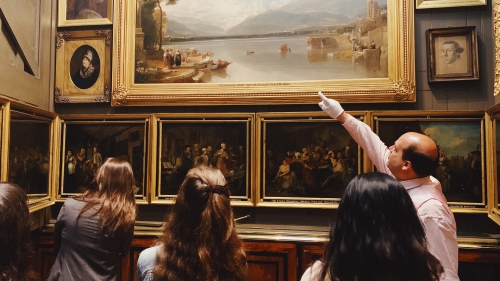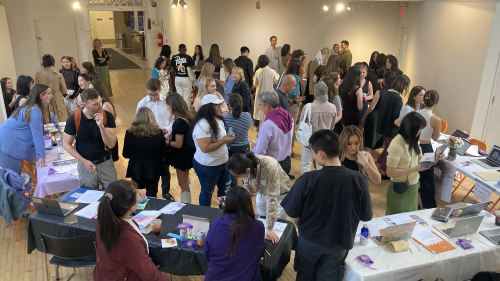
The Inaugural Visual Arts Administration Final Projects Showcase in the Barney Building Commons
After several years of planning and testing, the thesis requirement in NYU Steinhardt's Visual Arts Administration program has been changed to a “capstone” model.
In this regard, it has meant changing the Fall semester Research course to an instructor-led seminar about a specific theme related to arts administration relevant to student interests. During the Spring semester, students complete a Final Project in weekly sessions where work-in-progress is shared with classmates and faculty.
This year, students created podcasts, documentaries, websites, probing essays, reports from the field, and more on topics ranging from public engagement, concepts of value, art and technology, and collection issues. To celebrate this remarkable work, the program hosted its inaugural Final Projects Showcase on Monday, May 15th, from 2:00-3:30 PM in the Barney Building Commons. Like an art fair, student groups were given a table to present their final projects to their peers and community members.
Read on to learn more about selected student projects and the Visual Arts Administration program:
Jennifer Chen: Let’s Talk About Your Friend’s Art (LAYFA)
Section theme: Art and Audience
Project Statement:
Do not feel like you need extensive knowledge to be comfortable engaging with art. Everyone should be able to interpret art from their own perspective as long as they approach it with an open mind. Let's Talk About Your Friend's Art (LTAYFA) is a WEB project BY JENNIFER CHEN. Chen invited four artists AND ONE FRIEND OF EACH ARTIST to speak with her about art. Each pair (artist/friend) know one another well socially, but the artists tend not to discuss their artwork with the selected friend. Chen discovered there is a certain MAGIC IN FRIENDSHIP. The discussions open ways of understanding art for everyone. On the website, explore each conversation and ask yourself: what changes when you get to know an artist? How do the conversations on LTAYFA help you "see" the artwork in a new way?
Reflections from Jennifer:
“Through this project, I have gained a deeper understanding of how to engage the general public in the arts. I am amazed by the power of friendship and how it can be a valuable tool in creating meaningful and impactful art experiences. I believe my primary learning from this project is that: to make engagement happen, you need to put enough trust in the audience.
This project has transformed previously undervalued opinions into something supportive of understanding the arts. The website design is amiable to the public, with a focus on emphasizing the participants and their works. The storytelling style is also friendly, avoiding academic language and jargon. Every design element in the project ultimately loops back to the core value of engaging the audience.”
Zheng Du and Yilei Yang: Art in Action: Socially Engaged Art In the Chinese Context
Section theme: Art and Audience
Reflections from Zheng and Yilei:
Zheng Du: “Our project centers on socially engaged art (SEA) in the Chinese context. Initially, we hypothesized that implementing SEA initiatives in China would require a different approach than in Western contexts. This hypothesis was proven correct, yet I have since realized that I placed too much emphasis on the differences between the two contexts and neglected the common goal and core essence of socially engaged art: to truly integrate the community's needs and use art as an approach to improve society. In the cases we discussed in our podcast, there are many instances of grassroots initiatives rooted in communities and taking the public as a primary focus in all corners of China, such as Dinghaiqiao Mutual Aid Society, Picun Migrant Workers Museum, and Yangdeng Cooperative Society, among others. We have begun to reconsider the definition of socially engaged art in China and determine which cases qualify as such and which do not."
Yilei Yang: “Last semester, when I first encountered the concept of 'socially engaged art,' I had a rather vague idea of what it is and why it is important. How does it challenge the traditional definition of art? It seemed to be a counterforce to the white cube concept, but how? The basic questions: What is an artist? What is art? Another set of questions came up when I reflected on the different specific contexts of art and society in East Asian regions compared to the Euro-American framework.
"As the saying goes, ‘If you want to go fast, go alone. If you want to go far, go together.’ Although what I want to say may not be the original meaning of the proverb, it expresses my realization that counter voices are significant, both for our practice and the topic of socially engaged art. If there is one public, one main voice, then we will only have a direction to go, and everything moves rapidly. Countervoices could be a counterforce against efficiency, but it is all about what we value (more). Diversity or efficiency? Totality or individual wellness? Financial wealth or perceptual/moral richness?
"Looking back, the whole process is building a framework based on research -> making an interviewees list -> designing questions -> conducting interviews -> creating scripts -> collecting audio materials & recording -> editing -> testing -> revising.”
Zheng: “The most meaningful thing that this project brought to me is the new understanding and recognition of complexity. In an interview with Chenyun, the initiator of Dinghaiqiao Mutual Aid Society, she mentioned the downside of rapid urbanization, which led to the disintegration of community. She said that 'the disappearance of these social units is a loss for Shanghai, not for individuals.' To me, this idea is extremely powerful. As we are repeatedly persuaded and even seduced by visions of the 'better life' (mainly material life, such as moving from shantytowns to walled buildings) and fantasies of 'social prosperity', she reminds us of what is fading from another perspective. It is these fading 'connections'––even to a person or a tree––that form the basis of our personal lives and the richness of our public ones.”
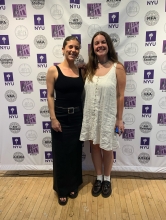
Natalia Vargas and Fernanda Escalera posing at Barney
Natalia Vargas: Soy De Aqui De Alla / From Here and There
Section theme: Art and Audience
Project Statement:
Soy de Aqui Y De Alla is a platform that supports Latinx artists and amplifies their voices, a place where the community can feel represented and where visitors to the site can celebrate and learn about the diverse experiences and stories of the Latinx community. A key theme is the complex power dynamics and leadership roles of museums, highlighting the need for diverse representation and inclusive leadership.
The title, Soy De Aqui Y De Alla/From Here And There, embodies the rich and complex experiences of the Latinx migrant community in East Harlem. The phrase "Soy De Aqui Y De Alla" captures the sense of dual identity that many migrants feel, where their hearts are split between their country of origin and their new home. The use of both Spanish and English in the name is a nod to the bilingual and bicultural nature of the community, and the website's content aims to reflect this diversity of language and culture. Through this platform, I share stories and perspectives from artists and residents of East Harlem with the world, celebrating the vibrant and colorful tapestry of Latinx culture. The website represents a celebration of the Latinx community's rich cultural heritage and a heartfelt exploration of the many facets of their lives and experiences.
Reflections from Natalia:
“At the start of my project, I embarked on a somewhat chaotic exploration of multiple topics, driven by my deep ambition to better understand my passion for the arts and the intersectionalities of various important aspects such as museums, public art engagement, food, and culture. I was intrigued by the underlying essence of the "art world" and hoped that this research project would finally provide the answers that had eluded me for years. However, as I delved deeper into the research process, I began to realize that the project was not just about finding answers to my questions but also about discovering hidden topics that I had never considered before. The project's strength is in its ability to help people truly understand a place and its culture. I was able to do this by telling a complicated story based on my own experiences, which made it more relatable. By sharing my personal perspective, I believe I’m able to create a connection with my audience and show them a different side of things.
This project has helped me clarify something that I always suspected deep down: I want to work in the arts but in a field where I can make a positive impact on the community. Through my work on this project and the insights I gained about East Harlem, I have realized that giving voice and representation to underrepresented communities is particularly important to me. I am grateful for the opportunity to learn about East Harlem and contribute to the conversation about its cultural landscape. This experience has confirmed my commitment to using my skills and knowledge to promote social justice and community empowerment.
Cindy Tibazarwa: AFRISANAA
Section theme: Art and Collections
Project Statement:
The first edition of AFRISANAA will dive into the world of the collector of contemporary African Art, the value the collectors create, and how they define authenticity within their collections. Sanaa is the Swahili word for Art, and the combination of Afri– AfriSanaa represents African Art, the heart of this magazine. When I began work on this edition, I had an interesting conversation with a colleague about creating value and how collectors and museums create value, especially in the context of African Art. How museums categorize and display the objects they acquire has a role in how Art is perceived and valued and its functionality as an art object. Museums, however, are not the only ones to do this - the restricted categorization of African Art as objects had been mainly due to the tastes and preferences of not only artists but collectors, dealers, and critics too." All stakeholders within the art world influence defining the parameters of contemporary African Art.
Reflections from Cindy:
“Working on my final project has been a challenging yet rewarding experience. I am really proud of my project and did not think I would make such a great publication. I started off wanting to create a “mock” magazine of the Nka: Journal of Contemporary African Art; however, I am glad that the final product is an original publication of my own. It made my thesis feel more personal, and I had a lot more creative license when designing the magazine. In focusing on my area of interest, contemporary African Art, this project has given me the confidence to keep striving in this field in contributing to the scholarship and pushing forward the talented and innovative artists in it.“
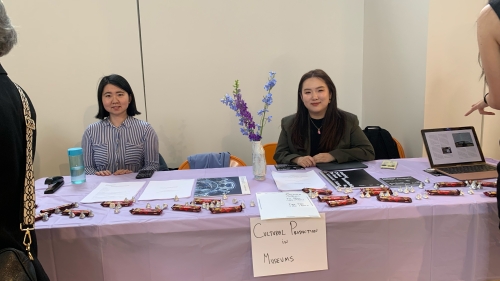
Yu Shen and Tian Hao
Alicia Diaz Eseverri: Collecting Dialogues
Section theme: Art and Collections
Project Statement:
“Collecting Dialogues” is a podcast series that explores how and why private collectors collect and how they accommodate to socially engaged practices. The podcast includes conversations with individuals engaged at the moment in contemporary collecting activities. The main focus will be to shed light on the different collecting practices collectors are involved in nowadays, their preference on how and where to buy, and how and why they buy art and cultural artifacts. Collecting through a socially engaged lens and what this means to each collector will be the project's core theme. Do they believe they are following trends of representation? Are they collectors because of passion and love of art? Are they interested in collecting as a business so they can later flip the art?
Reflections from Alicia:
“Through this project, I gained a deeper understanding of the needs and motivations of young collectors. I truly believe that this experience has equipped me to jumpstart my career as an art advisor and dealer, serve the needs of my surrounding art community, and successfully promote the careers of emerging artists. During our conversations, I found it interesting that some of today's young collectors do not prioritize themes of representation, or at least not as the traditional art world demands. Nonetheless, it was beautiful to hear how they all collect things that inspire and speak to them, regardless of market value. There is a desire to support emerging artists, prioritize them above all else, and purchase art that feels transgressive and unique, art that talks about something and inspires change. This insight is valuable for my future work in the art world, as it helps me to understand the motivations and values of collectors and how to best serve and promote emerging artists."
Xinyi Tang: M+ Collection Data
Section theme: Art and Collections
Project Statement:
The M+ Museum in Hong Kong houses four permanent collections—the M+ Collection, M+ Sigg Collection, M+ Library Special Collection, and M+ Collection Archives, each serving a different purpose. This project analyzes the nationality and gender composition of two of these collections, the M+ Collection and M+ Sigg Collection, specifically through the analysis of the museum’s metadata.
This project asks the following questions: Are artists of all genders equally represented? Is the collection a reflection of M+’s mission “to become a global hub for visual culture in Asia”? This project also presents one method of how we can assess if a museum is staying true to its collection policies and mission.
Reflections from Xinyi:
“M+ Museum has been one of my favorite institutions in terms of its ambition, mission, and the culture they are trying to promote. Thus when I was brainstorming for the topic of my final project, the collections of M+ were the first option I looked into. Having my previous project on the metadata and open access program M+ initiated, I finally decided to take a quantitative approach to the collection’s open data.
"The process was tough and painful since I am quite an amateur in data analysis, and I was only introduced to coding with Python last Fall semester. Cleaning the .csv file of the metadata was the biggest challenge since the data was formatted for cataloging; it took me around one month to arrive at the finalized data frame. The process pushed me to explore some more Python libraries that I had not worked with before and train myself on how to identify useful variables.
"The visualization part was fun since you get to see how these piles of numbers and entries turned into a centralized graph. I have experimented with different types of charts and finalized the presented histogram, pie charts, choropleth map, and race plots. Extracting a storyline from the visualizations was challenging, but it really helped me to improve my analytical skills through summarizing and connecting the data analysis findings. The website was built through Webflow (originally planned with Squarespace, but I opted out since it does not allow HTML code customization). The platform is not as user-friendly as I initially expected, but the previous HTML knowledge saved me and really revived this long-abandoned skill of mine.
"It has been quite a journey to create this website. Despite all the hardships, I was able to polish my newly acquired coding skills, improve my analytical skills, and revisit my HTML skills. I hope I can take these with me in my professional career and make the best use out of them.”
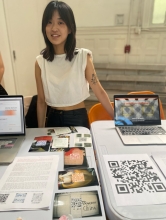
Melody Yu
Melody Yu: C0VID China
Section theme: Art and Technology
Project Statement:
COVID China is an NFT series that documents and records the reality and artworks created during the COVID pandemic with a focus on Chinese artists and Chinese social and political reality. There has been much controversy arising from Chinese policies regarding the COVID crisis since 2019. The project C0VID China with a number 0, took its name from the highly controversial “zero-COVID policy” from China, which has caused many tragedies in China. After the tragedy of the Xinjiang fire, there has also been the monumental “A4 movement,” the first protest ever after the “Tiananmen Massacre” in 1989. The Chinese government abolished the lockdown policy after the movement while also censoring and punishing all people involved in the movement, causing the COVID peak and countless deaths in China (which ironically justifies the lockdown policies). This project is designated to memorize and probe into what this crisis has left us in human history, especially under the special circumstance of the Chinese social and political contexts where everything is censored. There will be artworks critical of the political decisions that the Chinese government made as well as emotional ones dedicated to the crisis.`The medium of NFT bears an anonymous nature that is suitable to discuss the content. The entire project will also use processed images collected from news and various artists into a retro television aesthetics to render a sense of surveillance.
Carina Yang: A Mobile App to Match Buyers and Art Administrators
Section theme: Art and Technology
Project Statement:
I designed a mobile app to pair art buyers and collectors with arts administrators. The current state of mobile apps in the art market is one of rapid growth and evolution as new technologies and business models emerge to meet the changing needs of the industry. The success of platforms such as Artsy and Paddle8 has inspired the launch of new and diverse offerings, ranging from art investment platforms like Arthena and Masterworks to virtual art fairs like Art Basel. Despite the rapid growth of the art market, it remains an industry with many challenges and opportunities, and mobile apps will play an increasingly important role in shaping its future. Whether through new and innovative models for buying and selling art or through new ways to engage with art and artists, mobile apps are sure to continue to be an important part of the art market for years to come.
. . .
The Visual Arts Administration MA program was the first in the nation to focus on visual arts management careers in both traditional and alternative contexts. The program prepares leaders for a broad range of arts organizations. It takes into account the cultural and economic impact of the visual arts, nationally and internationally, as well as the challenges facing the arts today.

